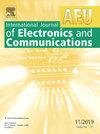Design and parametric characterization of CNTFET based stable static random access memory bit-cell for low-power applications
IF 3
3区 计算机科学
Q2 ENGINEERING, ELECTRICAL & ELECTRONIC
Aeu-International Journal of Electronics and Communications
Pub Date : 2025-02-01
DOI:10.1016/j.aeue.2024.155642
引用次数: 0
Abstract
The Carbon Nanotube Field Effect Transistor (CNTFET) is rapidly emerging as an attractive alternative to traditional CMOS transistors. In this work, a stable Feedback Cutting, PPN inverter based 10 transistor (FCPPN10T) Static Random Access Memory (SRAM) bit-cell design based on CNTFETs has been designed for low-power operations. The proposed cell has been tested for key parametric variation of CNTFET transistors such as chiral vector, pitch, number of carbon nonotubes, dielectric constant, and oxide thickness. The proposed FCPPN10T SRAM cell improves read/write static noise margin by 1.98/ 1.132, respectively, at 0.3 V compared to conventional 6T SRAM that uses similar CNTFET parameters. The read/write delay of proposed FCPPN10T is higher by 1.03/ 1.24, respectively, at 0.3 V compared to conventional 6T SRAM. The leakage power of proposed design is improved by 4.118 compared to conventional 6T. The proposed design parameters are also compared with three pre-proposed SRAM bit-cells. The simulation is performed with the Cadence Virtuoso using the Stanford University 32 nm CNTFET Verilog model.
碳纳米管场效应晶体管(CNTFET)正在迅速崛起,成为传统 CMOS 晶体管极具吸引力的替代品。在这项工作中,设计了一种基于碳纳米管场效应晶体管的稳定反馈切割、PPN 逆变器 10 晶体管(FCPPN10T)静态随机存取存储器(SRAM)位元设计,用于低功耗操作。针对 CNTFET 晶体管的关键参数变化(如手性矢量、间距、碳非管数量、介电常数和氧化物厚度),对所提出的位元进行了测试。与使用类似 CNTFET 参数的传统 6T SRAM 相比,所提出的 FCPPN10T SRAM 单元在 0.3 V 电压下的读/写静态噪声裕度分别提高了 1.98 倍和 1.132 倍。与传统 6T SRAM 相比,在 0.3 V 电压下,拟议 FCPPN10T 的读/写延迟分别增加了 1.03×/ 1.24×。与传统 6T 相比,拟议设计的泄漏功率提高了 4.118 倍。此外,还将拟议的设计参数与预先提出的三个 SRAM 位单元进行了比较。仿真由 Cadence Virtuoso 使用斯坦福大学 32 nm CNTFET Verilog 模型完成。
本文章由计算机程序翻译,如有差异,请以英文原文为准。
求助全文
约1分钟内获得全文
求助全文
来源期刊
CiteScore
6.90
自引率
18.80%
发文量
292
审稿时长
4.9 months
期刊介绍:
AEÜ is an international scientific journal which publishes both original works and invited tutorials. The journal''s scope covers all aspects of theory and design of circuits, systems and devices for electronics, signal processing, and communication, including:
signal and system theory, digital signal processing
network theory and circuit design
information theory, communication theory and techniques, modulation, source and channel coding
switching theory and techniques, communication protocols
optical communications
microwave theory and techniques, radar, sonar
antennas, wave propagation
AEÜ publishes full papers and letters with very short turn around time but a high standard review process. Review cycles are typically finished within twelve weeks by application of modern electronic communication facilities.

 求助内容:
求助内容: 应助结果提醒方式:
应助结果提醒方式:


